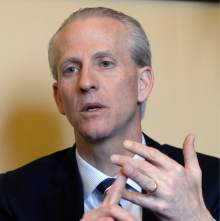This is an archived article that was published on sltrib.com in 2015, and information in the article may be outdated. It is provided only for personal research purposes and may not be reprinted.
Utah lawmakers got their first preview of a proposal hammered out in closed-door meetings by legislative leaders and Gov. Gary Herbert, seeking to provide health insurance coverage to as many as 126,500 low-income Utahns.
A key component, and likely a key challenge to passage of the newly rebranded Utah Access Plus proposal, is that it calls on medical providers — hospitals, doctors, pharmaceutical companies, home health care providers and others — to cover the bulk of the cost for the expanded coverage. The idea is that they will be the ones who will benefit from the new revenue.
Senate President Wayne Niederhauser, R-Sandy, said the state could have paid the entire cost, but that that would hurt funding for education, transportation or underfunded social services. Instead, letting the providers cover the cost was a better option, he said.
"There's going to be $450 million of federal money that hasn't been coming to Utah that will be coming to Utah now," Niederhauser said. "Wherever a dollar lands, we're asking for 7 cents back."
Those providers will be expected to contribute with about $52 million by 2021 through assessments, licensing fees or other mechanisms. Each doctor, for example, would pay about $800 more per year to renew a medical license, combining for about $9 million. Hospitals would be assessed an extra $23 million in taxes. Pharmaceutical companies would be expected to pay a total of $8 million.
"This is a bunch of new provider taxes. This is not going to be easy for any Republican caucus," Niederhauser said.
The federal government would provide $9 of federal Medicaid funding for every dollar the providers put into the program.
The $450 million that would generate would be used to buy insurance subsidies for Utahns making less than 138 percent of the federal poverty level. That federal metric is $24,250 for a family of four, making the subsidy level about $33,000 for a family of four.
The group representing the state's doctors has already expressed opposition to having to pay for the Medicaid expansion, and the state's hospital group has voiced concerns about getting stuck with the bill if enrollment and costs skyrocket.
The blueprint presented to Republican lawmakers in closed-door meetings Tuesday was the product of months of negotiations between the so-called Gang of Six — Gov. Gary Herbert, Lt. Gov. Spencer Cox, Niederhauser, House Speaker Greg Hughes, House Majority Leader Jim Dunnigan and Sen. Brian Shiozawa — after House Republicans refused to pass Herbert's proposed Healthy Utah plan in March.
"Without the [Gang of Six], Medicaid expansion would have been dead," Niederhauser said.
The Republican House members are again likely to be the toughest audience for the plan, with members having expressed skepticism over the cost and sustainability of the Medicaid expansion.
Democrats, too, were displeased Tuesday, as Republicans met behind closed doors, a move that Utah Democratic Party Chairman Peter Corroon said lets the majority party decide the fate of the program in debates hidden from the public they represent.
"This meeting is closed to the media, it's closed to non-Republicans and, most importantly, it's closed to you, the citizens of Utah," Corroon said. "Today, Speaker Hughes, we say open these doors, let Utahns have a voice."
Senate Democrats were briefed on the proposal, as well, however, with Niederhauser and Shiozawa visiting with the five-member caucus to lay out specifics of the plan.
"It seems to me like it's Healthy Utah with a hat on," said Sen. Karen Mayne, D-West Valley City, referring to Herbert's failed proposal.
Utah Access Plus will be presented to the public during a meeting of the Health Reform Task Force on Oct. 6. If it is well-received, there could be a special session in late October.
"If it's a lead balloon, I don't think we'll be having a special session," Niederhauser said.
Even if the bill wins approval from the Legislature, there would be work left to do. The state would have to apply for several waivers from the U.S. Department of Health and Human Services to make the plan work. That could take several months, and then deploying the plan could take several more months before any new enrollees would be covered.
The so-called "medically frail" population — those with the most need — would be enrolled in accountable care organizations, where they would receive more supervised medical treatment. The remaining population could receive subsidies to buy into commercial plans on the market. Shiozawa said states like Arkansas, which followed a similar model, saw costs reined in.
The new taxes, if the bill is approved, would begin being collected in 2017, while the federal government is still paying more of the cost of the program, allowing the state to build a reserve account of more than $100 million by 2021. That lets the state cover the costs should enrollment be up to three times what is anticipated.
Twitter: @RobertGehrke



